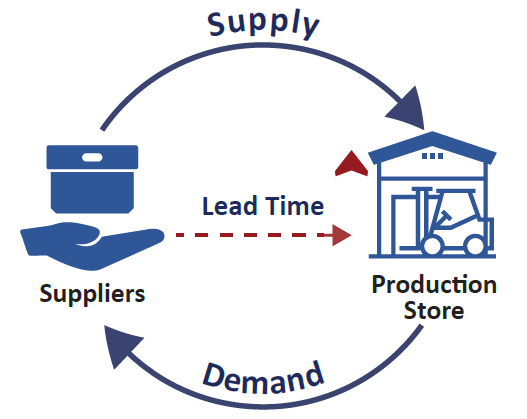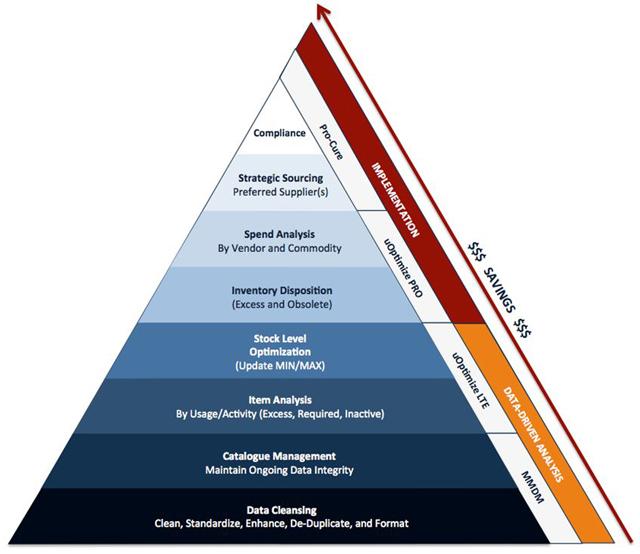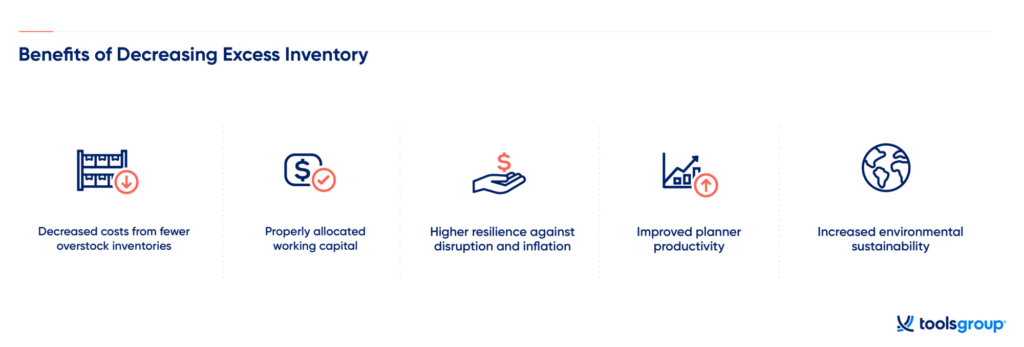Managing inventory is a critical aspect of supply chain management. However, excess and obsolete inventory can pose a significant challenge to businesses. With the right way, you can turn this challenge into an opportunity to optimize your supply chain and increase efficiency.
Are you struggling with how to reduce excess inventory in your supply chain? Do you want to optimize your excess inventory management and improve your bottom line?
This blog will share proven strategies for managing excess and obsolete inventory, allowing you to streamline your supply chain and reduce costs.

Defining Excess and Obsolete Inventory
Excess inventory and obsolete inventory are related concepts in the realm of inventory management. Excess inventory refers to the amount of inventory that exceeds the actual demand, whereas obsolete inventory is inventory that has reached the end of its useful life and is unlikely to be sold.
Both can be detrimental to a business as they tie up capital and storage space that could be used for other purposes. Managing inventory levels to avoid excess and obsolete inventory is crucial for effective inventory management.

The Causes of Inventory Obsolescence
Let’s explore some of the most common causes of inventory obsolescence and how businesses can mitigate these risks.
Poorly Estimated Inventory Forecasting
Inventory forecasting can be challenging when historical sales data and market trends aren’t available or accurate, leading to over-ordering and obsolete inventory. To avoid this, businesses can consider buying less inventory more often than ordering for an entire year.
Insufficient Inventory Management Systems
If an inventory is mismanaged, a retailer may buy too much or too little product. They may have to guess when to order more inventory without proper monitoring.
Limited Inventory Transparency
Having visibility over your inventory is crucial for effective inventory management, avoiding overstocking, and meeting customer demand. Without it, you risk stockouts and obsolete inventory, which can increase your carrying costs.
Inadequate Supply Chain Data
Access to supply chain data can provide valuable insights into production lead times, labor needs, warehousing, order fulfillment, and shipping—all of which can be used to improve supply chain efficiency and promote business growth.
Defective Product Quality or Design
Products with design or manufacturing issues or failing to meet customer expectations can lead to:
- Negative reviews
- Returns
- Excess inventory
Careless Purchasing Practices
Purchasing based on anecdotal knowledge or a desire for deals can result in excess inventory and lead to problems. Avoid this by ensuring purchases are based on accurate data and market analysis.
Inaccurate Lead Time Estimations
Extended lead times longer than expected can be problematic because demand for a product could drop before an organization receives the goods. This can lead to obsolete inventory and an inability to be agile in market changes.
Now that we have explored some of the most common causes of excess and obsolete inventory let’s examine some strategies for managing it.
10 Strategies to Reduce Excess and Obsolete Inventory
Here are effective strategies you can use to reduce excess and obsolete inventory:

Use Demand Forecasting to Prevent Excess Inventory
Excess inventory can lead to selling obsolete inventory, which can result in significant losses for a business. To prevent this, you must use demand forecasting techniques that consider factors such as demand trends, seasonality, and promotional activity.
This can be achieved through statistical demand forecasting carried out by inventory optimization software, which can analyze every product in a portfolio and assign a demand type based on its position in the product life cycle.

Ensure Inventory Availability and Visibility Across All Sales Channels
Ensuring inventory availability and visibility across all sales channels means businesses have a clear and accurate understanding of their inventory levels and locations, regardless of the sales channel used.
This allows them to allocate inventory efficiently to different locations and sales channels. By leveraging real-time inventory data, businesses can make informed decisions and quickly adapt to changing customer demands.

Conduct Regular Inventory Audits
It helps to identify slow-moving items, obsolete inventory, and dead stock that can take up valuable storage space and increase holding costs. By performing regular audits, businesses can quickly remove these items and optimize storage space, allowing for a higher volume of faster-selling products.
It also helps businesses make informed decisions about reordering, pricing, and promotions, ultimately leading to increased profitability.

Understand Your Reorder Point
To prevent unnecessary inventory, staff must understand when and how much they should replenish.
The software can sound the alarm for buyers to reorder items yet supply chain personnel must be vigilant in monitoring any unexpected surge or decline in sales of a specific item.

Track Inventory Levels in Real-Time
Access to real-time inventory data helps organizations optimize purchasing decisions and reduce obsolete stock. Supply chain employees must be able to monitor inventory levels for each SKU to make informed decisions, such as placing purchase orders or promoting products.
ERP inventory systems use various data sources to provide valuable insights into the performance history of different SKUs, ensuring that employees have the most up-to-date information to make informed decisions.

Avoid Relying on Excess Inventory as A Solution for Supply Risks
Businesses should proactively manage potential disruptions by planning supplier holidays and monitoring supplier lead times.
By adjusting lead times, reordering points accordingly, and implementing adequate buffer stock to cover delays, businesses can avoid overstocking and optimize their inventory levels while mitigating supply chain risks.

Prevent Stockouts by Eliminating Excess Inventory
It’s a misconception that holding a lot of stock is necessary to achieve high service levels. Instead, businesses can use inventory optimization techniques to prioritize which items to the stock based on multi-dimensional criteria such as:
- Demand types
- Pick frequency
- Demand volatility
- Cost to sell
Businesses can maintain high product availability without carrying excess inventory by setting stock levels according to sales performance and cost.

Optimize Inventory Levels Throughout the Supply Chain
Businesses with multi-tier supply chains or multiple locations often face challenges in preventing stock. By having a correct view of inventory levels across sites and tiers, businesses can avoid unnecessary stockholding and ensure that products are available in the right place at the right time.
By managing inventory levels through collaborative planning and collaboration, businesses can improve their inventory performance and optimize operations throughout the supply chain.

Implement Inventory Management Software
With the ability to track inventory movement in real-time and receive alerts for low inventory levels, businesses can reduce the risk of obsolete inventory and ensure they always have the right amount of stock on hand.
Inventory management software can automatically generate reports and provide valuable KPIs to help businesses make informed inventory levels and forecasting decisions.

Make Informed Purchasing Decisions to Manage Inventory Effectively
To manage inventory effectively, you must decide wisely. Before making a purchase, consider the demand for the product and whether it’s likely to move quickly off the shelves.
Be mindful of minimum order quantities, and don’t be afraid to renegotiate to avoid excess inventory. Paying a higher unit rate for smaller order quantities may be more cost-effective than having cash tied up in slow-moving stock.
These strategies can help you manage excess and obsolescence inventory, streamline supply chain operations, and reduce costs. Optimizing inventory levels and monitoring purchasing decisions can ensure you are not overstocking and improve your bottom line.
The Consequences of Too Much Inventory on Hand
Too much inventory on hand causes various consequences, especially if the inventory becomes obsolete. Obsolete inventory can result in:
- inventory write-offs
- decreased market value
- increased waste
All these impact a business’s financial health and long-term viability. It can:
- Negatively affect profitability, making it difficult for a company to attract investors or qualify for loans
- Take up valuable space in the warehouse, limiting the storage of profitable and fast-moving products
Therefore, you must keep their inventory levels under control and regularly review and dispose of any obsolete inventory to avoid these consequences.
Benefits of Managing Obsolete Inventory
Reducing obsolete inventory has numerous benefits. It includes:
- Strengthening the financial standing of a business
- Reducing inventory costs and limiting the amount of stock written off so you can save money while maintaining a healthy supply.
- Businesses can pour more resources into other projects to further drive their success.

Minimizing the presence of obsolete stock not only boosts profitability but also ensures that financial statements are accurate and allows businesses to calculate their current inventory carrying costs.

Maximize Your Profits with Prudent Excess and Obsolete Management!
Effective management of excess and obsolete inventory is a pivotal step toward increasing revenue. Through real-time inventory tracking, informed purchasing decisions, and eliminating obsolete inventory, businesses can optimize stock levels and free up capital tied up in slow-moving stock.
If you are struggling to manage your excess or outdated inventory, Hopewell Logistics can provide reliable supply chain management solutions.
Partner with us, and let’s create a customized inventory management system that streamlines your supply chain operations, paving the way for growth and increased profitability. Connect with us today and start realizing the benefits of prudent excess and obsolete management.






